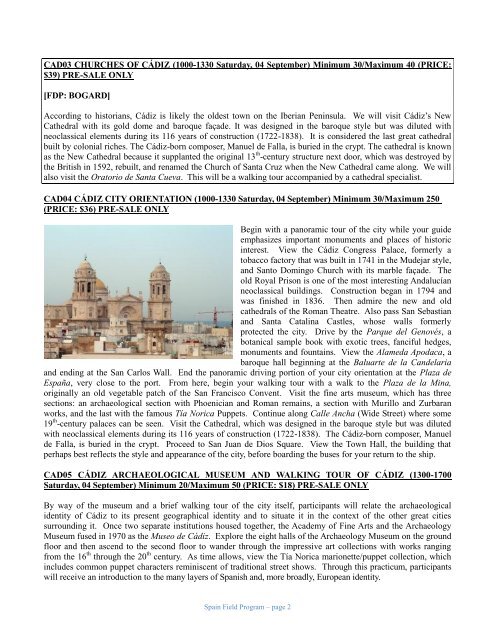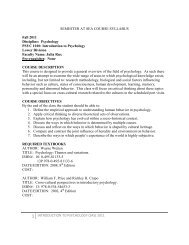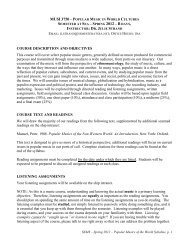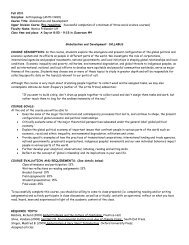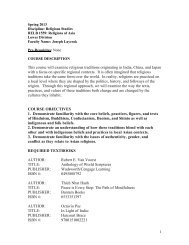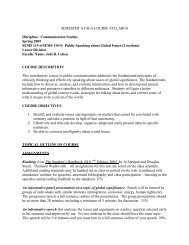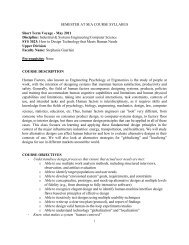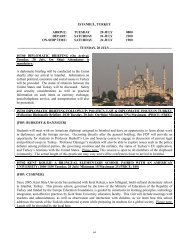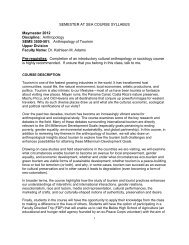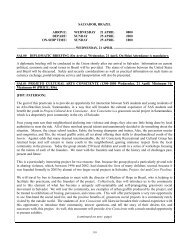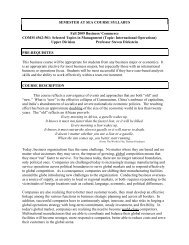Final Field Program - University of Virginia
Final Field Program - University of Virginia
Final Field Program - University of Virginia
Create successful ePaper yourself
Turn your PDF publications into a flip-book with our unique Google optimized e-Paper software.
CAD03 CHURCHES OF CÁDIZ (1000-1330 Saturday, 04 September) Minimum 30/Maximum 40 (PRICE:<br />
$39) PRE-SALE ONLY<br />
[FDP: BOGARD]<br />
According to historians, Cádiz is likely the oldest town on the Iberian Peninsula. We will visit Cádiz’s New<br />
Cathedral with its gold dome and baroque façade. It was designed in the baroque style but was diluted with<br />
neoclassical elements during its 116 years <strong>of</strong> construction (1722-1838). It is considered the last great cathedral<br />
built by colonial riches. The Cádiz-born composer, Manuel de Falla, is buried in the crypt. The cathedral is known<br />
as the New Cathedral because it supplanted the original 13 th -century structure next door, which was destroyed by<br />
the British in 1592, rebuilt, and renamed the Church <strong>of</strong> Santa Cruz when the New Cathedral came along. We will<br />
also visit the Oratorio de Santa Cueva. This will be a walking tour accompanied by a cathedral specialist.<br />
CAD04 CÁDIZ CITY ORIENTATION (1000-1330 Saturday, 04 September) Minimum 30/Maximum 250<br />
(PRICE: $36) PRE-SALE ONLY<br />
Begin with a panoramic tour <strong>of</strong> the city while your guide<br />
emphasizes important monuments and places <strong>of</strong> historic<br />
interest. View the Cádiz Congress Palace, formerly a<br />
tobacco factory that was built in 1741 in the Mudejar style,<br />
and Santo Domingo Church with its marble façade. The<br />
old Royal Prison is one <strong>of</strong> the most interesting Andalucían<br />
neoclassical buildings. Construction began in 1794 and<br />
was finished in 1836. Then admire the new and old<br />
cathedrals <strong>of</strong> the Roman Theatre. Also pass San Sebastian<br />
and Santa Catalina Castles, whose walls formerly<br />
protected the city. Drive by the Parque del Genovés, a<br />
botanical sample book with exotic trees, fanciful hedges,<br />
monuments and fountains. View the Alameda Apodaca, a<br />
baroque hall beginning at the Baluarte de la Candelaria<br />
and ending at the San Carlos Wall. End the panoramic driving portion <strong>of</strong> your city orientation at the Plaza de<br />
España, very close to the port. From here, begin your walking tour with a walk to the Plaza de la Mina,<br />
originally an old vegetable patch <strong>of</strong> the San Francisco Convent. Visit the fine arts museum, which has three<br />
sections: an archaeological section with Phoenician and Roman remains, a section with Murillo and Zurbaran<br />
works, and the last with the famous Tía Norica Puppets. Continue along Calle Ancha (Wide Street) where some<br />
19 th -century palaces can be seen. Visit the Cathedral, which was designed in the baroque style but was diluted<br />
with neoclassical elements during its 116 years <strong>of</strong> construction (1722-1838). The Cádiz-born composer, Manuel<br />
de Falla, is buried in the crypt. Proceed to San Juan de Dios Square. View the Town Hall, the building that<br />
perhaps best reflects the style and appearance <strong>of</strong> the city, before boarding the buses for your return to the ship.<br />
CAD05 CÁDIZ ARCHAEOLOGICAL MUSEUM AND WALKING TOUR OF CÁDIZ (1300-1700<br />
Saturday, 04 September) Minimum 20/Maximum 50 (PRICE: $18) PRE-SALE ONLY<br />
By way <strong>of</strong> the museum and a brief walking tour <strong>of</strong> the city itself, participants will relate the archaeological<br />
identity <strong>of</strong> Cádiz to its present geographical identity and to situate it in the context <strong>of</strong> the other great cities<br />
surrounding it. Once two separate institutions housed together, the Academy <strong>of</strong> Fine Arts and the Archaeology<br />
Museum fused in 1970 as the Museo de Cádiz. Explore the eight halls <strong>of</strong> the Archaeology Museum on the ground<br />
floor and then ascend to the second floor to wander through the impressive art collections with works ranging<br />
from the 16 th through the 20 th century. As time allows, view the Tía Norica marionette/puppet collection, which<br />
includes common puppet characters reminiscent <strong>of</strong> traditional street shows. Through this practicum, participants<br />
will receive an introduction to the many layers <strong>of</strong> Spanish and, more broadly, European identity.<br />
Spain <strong>Field</strong> <strong>Program</strong> – page 2


